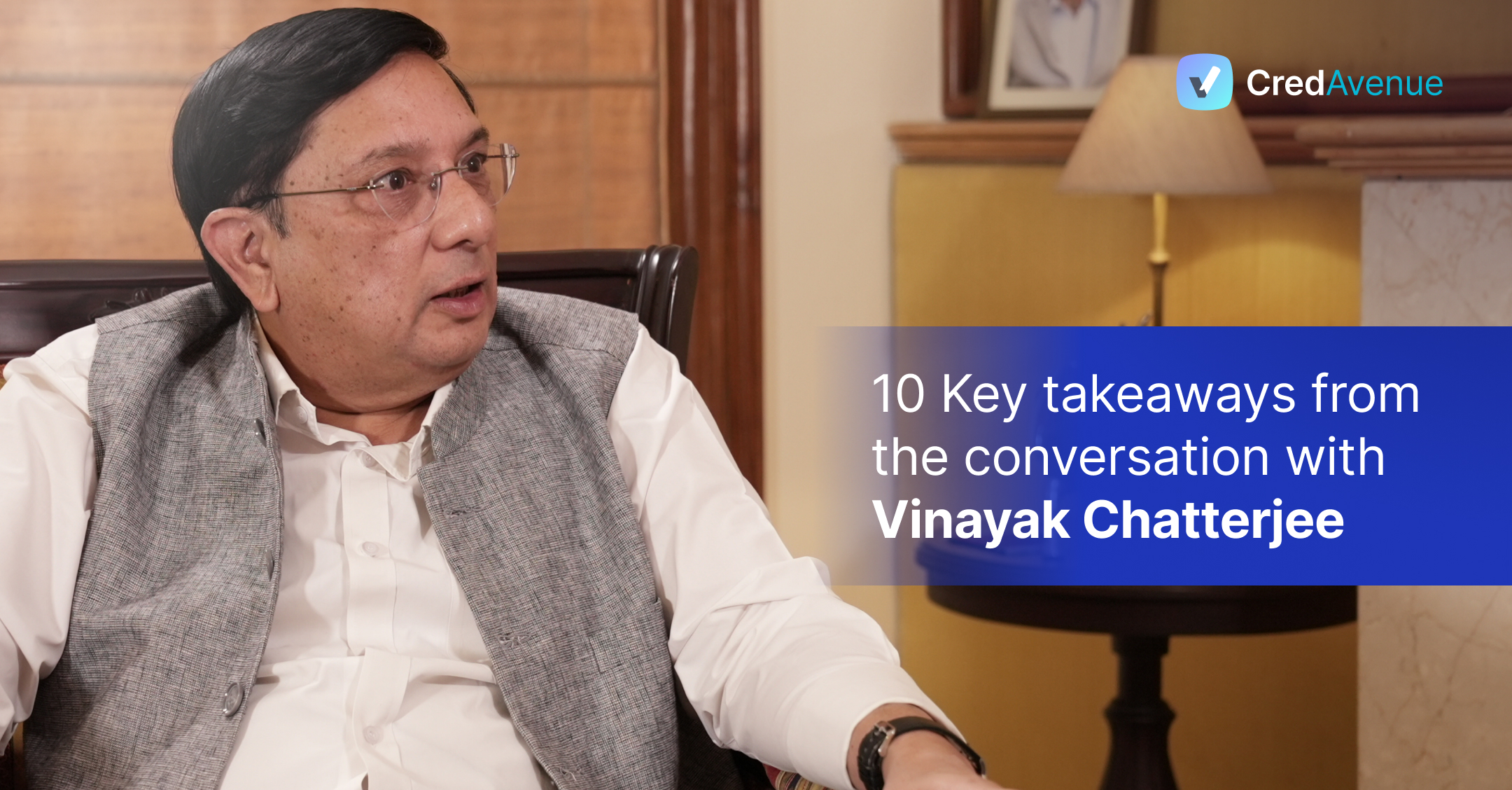
Debt financing plays a crucial role in putting a business on the path to growth and success. Debt financing, when done right, can not only unlock value for the business but also contribute to the national economy.
CredAvenue, India’s largest institutional debt platform, is trusted by 2,000+ enterprises and makes it easier for businesses to access finance. With its video series titled ‘ExpertTake’, CredAvenue aims to bust common misconceptions around financing and help businesses with the right information from industry experts.
In its latest session, CredAvenue connected with Mr Vinayak Chatterjee, chairperson of the National Council of Infrastructure and head of CII’s National Task Force on Regulatory Framework in Infrastructure. Mr Chatterjee offered valuable insights about infrastructure financing in India in his conversation with Shubham Jain, CredAvenue’s infrastructure and real estate platform head.
Here are the key takeaways from this insightful conversation:
1. Government’s emphasis on infrastructure investment
According to Mr Chatterjee, the link between infrastructure and macroeconomy is worth exploring and should be the starting point of any conversation about infrastructure financing. He thinks that the government has decided that the expenditure and investment in infrastructure will pump-prime the economy and stimulate GDP growth. A Government of India research report quoted by the secretary of finance, Dr Somnathan, at one of the post-budget meetings highlights the perception of the government that regards infrastructure developments as the primary way of stimulating GDP.
According to the report, every Re. 1 spent on infrastructure leads to a GDP stimulation of Rs. 3. In contrast, the same expenditure through direct transfer to consumers results in a mere 90p in GDP growth.
The previous budgets have seen major investments by India’s government into infrastructure. That seems like the right thing to do because it has the greatest multiplier effect and positively affects the GDP.
2. The ideal amount of infrastructure investment for India
In the conversation, he also aimed to explore the right level of investment in infrastructure for any country. Mr Chatterjee emphasised that there is no single answer to this. Over the years, economic historians have agreed that the GCFI, i.e. the Gross capital formation in infrastructure as a percentage of GDP, is the best measure of GDP. Different countries at different levels of economy have revealed different levels of spend. However, over the years, economists, finance experts, and governments have concluded that India must reach 8-9% of GCFI.
3. Status of India in terms of meeting the GCFI
The national infrastructure pipeline postulates Rs. 111 lakh crores towards infrastructure over 5 years. If an annual allocation is computed and compared with the current nominal GDP of Rs. 240 lakh crores, the GCFI comes to 8-9%, and even in a not-so-good performance, it’d come to roughly 7-7.5%. The level of spending on infrastructure is thus directionally correct. This is a sign that infrastructure spending is yielding the desired results.
4. The impact of Covid on NIP spending and GCFI and what India needs to make up
The NIP aims to spend Rs. 22 lakh crores per annum on infrastructure. However, this was announced before the pandemic stuck, and a lot has changed after that. Over the last 5 years, the average spend has been at Rs. 10-11 lakh crores. However, this is the data up to 2019. The figures for 2020- 2021 and 2021-2022 are still awaited. Mr Chatterjee expects them to be somewhere around Rs. 14-15 lakh crores. There are only two drivers that can narrow this gap: the availability of capital and the availability of an adequate pipeline for projects.
5. It isn’t about funding anymore but the availability of shovel-ready projects
- Exploring India’s capability to invest huge sums as capital in infrastructure
The financial capability of the country to invest in infrastructure projects can be judged from the buckets of finance available. The union budget has allocated Rs. 7.5 lakh crores. While states typically allocate an equal amount, Mr Chatterjee assumed the figure to be Rs. 6 lakh crores. This discounted assumption is due to the fiscal stress that states are facing. Other financial buckets include extra-budgetary resources and PSUs (Rs. 3 lakh crores), domestic and private capital, and the newly instituted NABFID (national bank for financing infrastructure development) (Rs. 2 lakh crores). One can conclude that India has easily crossed the Rs 20 lakh crore financial barrier. India has, thus, reached maturity in its ability to finance infrastructure.
- Assessing India’s readiness for project execution and the availability of a project pipeline
Mr Chatterjee looked at some numbers to assess this. He assumed the average life of an infrastructure project to be 4 years and an investment of Rs. 20 lakh crores each year in shovel-ready projects. That requires a pipeline of Rs. 80 lakh crores. However, the pipeline is, unfortunately, not there. The NIP is attempting to chart a pipeline and, with optimistic calculations, estimates the investable pipeline to be at Rs. 50-60 lakh crores right now. This will also be consumed over the next 2 years. Thus, more than funding, the country needs a new generation of projects to add Rs. 40-50 lakh crores to the pipeline.
6. The plug-and-play approach to infrastructure development
India has overcome most hurdles in the national highway development program, such as land acquisition, removal of utilities, state support agreements, etc. After effectively tackling these challenges, India is now ready to consistently reach 40 kilometres of infrastructure development a day, possibly the highest in the world.
Electricity transmission has also been achieved in even the toughest terrains. Thus, the issue doesn’t lie with India’s capability. It has tackled challenges with the right approach in the past. There are still challenges, and India can tackle them with the right approach.
The plug-and-play approach to infrastructure development can be effective. This approach will involve the government taking care of all permissions, including land acquisition and removal of utilities, before issuing tenders for construction or development. They can do it in a 100% government-owned SPV (special purpose/project vehicle). The SPV will be a complete government entity with a CEO responsible for securing permissions, land acquisitions, and all other sovereign functions. Once the tasks are done, the shares can then be sold to the highest bigger who will be responsible for the future functions such as construction, etc. This plug-and-play approach will also get better bids because the private entities will have lesser risk and uncertainty.
7. The depth of the current system for plug-and-play infrastructure projects
The current system lacks depth because of the lack of investment appetite for public-private projects. Even the big corporate houses that have the balance sheet appetite lack the mood to invest in PPP projects because of sore experiences in the past and concerns about contract sanctity, unlevel playing field, inappropriate risk allocation, lack of support, etc.
The short-term solution to this can be that the government can continue using the EPC (Engineering, Procurement, and construction) model. This will involve building the infrastructure and then selling it. There is also a twinning policy of the national infrastructure pipeline and the national monetisation pipeline, a smart solution. This will eliminate the risk for the private players.
8. PM Gati Shakti and how it will affect investors and lenders in the infrastructure sector
PM Gati Shakti is a scientific and methodical approach to infrastructure development. In the past, infrastructure projects have faced challenges where the project’s location was surveyed and assessed for feasibility but not the connectivity. The projects would be completed only to realise that there are no roads or electricity transmission lines. Many times, the challenges led to orphaned projects.
PM Gati Shakti is a complex software built by a central government institution called BISAG. It is a specialised institution under the Ministry of Information Technology that specialises in using satellite-based technologies to achieve interlinkages.
So, whenever a new infrastructure project is planned in an isolated location, Gati Shakti tells what linkages are required in each layer. This includes water, roads, rail, electricity, broadband, etc. It thus helps the holistic development of a project, so there are no issues after the development.
PM Gati Shakti will also define a radius per shareholder agreement, and in that radius, a new competing project will not be approved. So, investors and lenders will not face the threat of being phased out due to other competing projects in the area. It also eliminates the risk of being an orphaned project by ensuring the availability of all necessary linkages.
9. The hope in the new DFI
India requires capital infrastructure and national development that offers economic returns and not just financial returns. The earlier schemes lacked the kind of structure to pronounce the capital as developmental capital. With the new DFI, the government is conscious that NABFIT offers developmental capital and thus has created facilitative conditions that will make it conducive to raising leverage debt quickly. It also has the benefit of a low-cost sovereign guarantee, and the entire political system is structured so that it will start performing immediately.
10. Bidding relaxations in the light of COVID and aggressive bidding
Earlier, when the criteria were stringent, only a handful of players got a chance to win projects. In the light of COVID, bidding relaxations make it easier for other players to prove their capabilities. However, there needs to be a balance. Adequate checks need to be in place to weed out aggressive bidders who are incapable, as project flaws and delays impose a high cost that the economy has to bear.
Mr Chatterjee offered great insights about infrastructure financing in India. He believes that we need to be more self-dependent in terms of military equipment and hydrocarbons to save ourselves from the global turmoil in the current geopolitical situation.
Watch the full video here.



